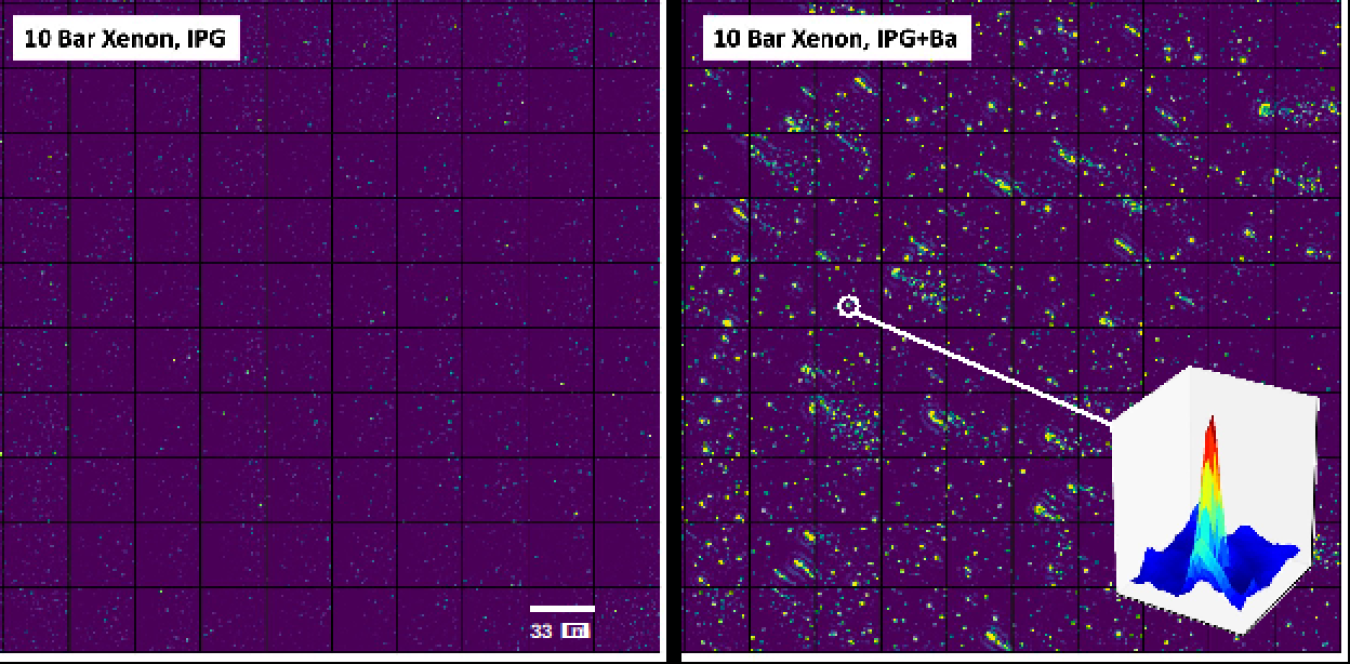Researchers imaged individual barium ions in dense xenon gas, offering a new path toward ultra-low-background searches for neutrinoless double beta decay.
June 25, 2025The Science
The nature of the neutrino’s mass is no small matter. It is directly connected with major questions in nuclear physics, particle physics, cosmology, and the origins of matter in the universe. To determine the mechanism by which neutrinos obtain their mass, experiments search for a hypothetical radioactive process called neutrinoless double beta decay. Current techniques are limited by cosmic rays and natural radioactivity. These factors create background noise that makes it difficult to spot double beta decay. An interdisciplinary team has demonstrated a powerful new way to identify these decays. The approach uses techniques from organic chemistry, optical microscopy, and nuclear physics to identify individual barium ions in dense gases.
The Impact
This advance may enable a future neutrinoless double beta decay search with extremely low background rates. This would lead to experiments that can test the nature of the neutrino with unprecedented levels of sensitivity and confidence. The technique the team invented for this research can also have wider applications in applied science. These include studies of catalysis of gases that are critical to advanced energy technologies and materials. Applications also include novel gas-phase sensors for monitoring industrial, defense, and other processes.
Summary
Detecting materials at the single-molecule or single-ion level represents the ultimate frontier of analytic chemistry. Searches for neutrinoless double beta decay through the imaging of individual daughter ions require novel instrumentation techniques that operate reliably and efficiently at this limit. These techniques must perform in the complex environment of a double beta decay experiment, such as a high-pressure xenon gas environment. Since 2016, the NEXT collaboration has pursued the development of a novel method of barium identification through single molecule fluorescence imaging. The technique uses an arrangement of novel organic molecules that switch from non-fluorescent to fluorescent upon binding with barium ions. The resulting fluorescent complex can be imaged with single-molecule-sensitive microscopes.
Researchers have now used the optical instrumentation developed for barium tagging to image single ions of barium in 10 atmospheres of xenon, employing molecular sensors that are specially designed to be responsive in these conditions. This is a major enabling step toward future background-free neutrinoless double beta decay searches.
Contact
Ben Jones
University of Texas at Arlington
Ben.jones@uta.edu
Frank Foss
University of Texas at Arlington
ffoss@uta.edu
Funding
This research was funded by the Department of Energy Office of Science, Nuclear Physics program; the National Science Foundation; and the Robert A. Welch Foundation. The NEXT Collaboration also receives support from the Fermi National Accelerator Laboratory, Argonne National Laboratory, the European Research Council, the European Union’s Framework Programme for Research and Innovation Horizon, the MCIN/AEI of Spain and ERDF A way of making Europe, the Severo Ochoa Program, the Ramon y Cajal program, the Generalitat Valenciana of Spain, the Department of Education of the Basque Government of Spain, the Portuguese FCT, the Pazy Foundation, and the Laboratorio Subterraneo de Canfranc.
Publications
Byrnes, N.K., et al. (NEXT Collaboration), Fluorescence imaging of individual ions and molecules in pressurized noble gases for barium tagging in 136Xe. Nature Communications 15, 10595 (2024). [DOI: 10.1038/s41467-024-54872-0]
Thapa, P., et al., Demonstration of Selective Single-Barium Ion Detection with Dry Diazacrown Ether Naphthalimide Turn-on Chemosensors. ACS Sensors 6, 1 (2021). [DOI: 10.1021/acssensors.0c02104]
Related Links
Learn more about the Neutrinos and Rare Event Searches Group at the University of Texas at Arlington.


